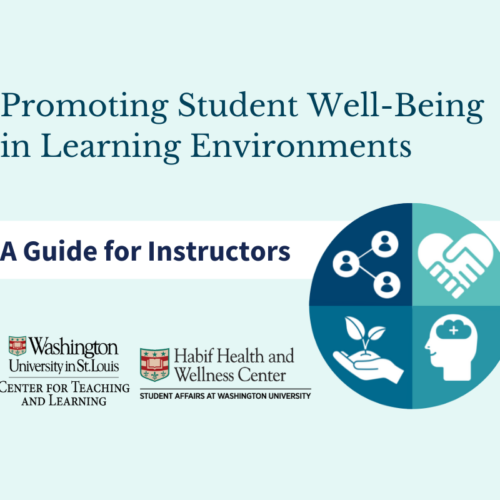Q&A from Supporting Students’ Mental Health in an Online Class with Habif Health and Wellness
The Center for Teaching and Learning and Habif Health and Wellness hosted a virtual conversation, “Supporting Students’ Mental Health in an Online Class,” on Monday, April 6. In the session, staff from Habif’s Mental Health Services (MHS) emphasized strategies for supporting students’ mental health in this new online environment. Staff also provided a brief update about resources and operations during this time.
During the second half of the session, there was time for questions and answers. Below is excerpts from that conversation from Dr. Tom Brounk, Director of Mental Health Services, Jessica Dyer, LCSW, Metal Health Services, Jordan Worthington, MSW, Assistant Director, Mental Health Outreach and Programming:
Q: How is MHS operating during this crisis?
A: All of our MHS staff are working remotely and are available to provide shorter, 30-minute phone check-ins to all students on the Danforth campus. They are also available to consult on accessing counseling in the areas where students are living. Online counseling sessions are still available to students who are currently residing in Missouri, as this is where all of our providers are licensed to practice. Our after-hours support line is still up and running – students can call 314-935-6666 and follow the prompts. We are also still promoting our free self-help app, TAO.
For any updates on MHS operations during this time, we recommend you check the Habif website.
Q: How can students reach out to MHS for help? What contact information should I give a student who says that they need help?
A: If a student is already connected with a mental health provider, they can reach out to their provider through a secure message through their online portal. If a student has not had previous contact with MHS, we recommend them calling 314-935-6695 to start the process.
Q: What are some challenges that students might be experiencing right now that could affect how they are able to engage with my class?
A: The reasons that students may be struggling are just as varied as the ways in which we are struggling! There are a number of students who hold identities that make them uniquely vulnerable during this time: international students, students of color, queer and trans-spectrum students who may be forced back into the closet back home, students living in situations with physical or emotional violence, students who are housing or food insecure, students who are caregivers, students with disabilities, and students who were already experiencing mental health issues.
Students are dealing with a wide range of emotions right now: uncertainty, fear for their own health and the health of others, frustration, boredom, and grief. Some students are able to use their schoolwork as a source of purpose or an outlet right now, but others simply need to focus on taking care of their mental and physical health during this period of collective trauma. As educators, we need to be sympathetic that there isn’t a roadmap for dealing with this, and everyone is going to cope and process in different ways unique to them.
Q: How can my course structure support students?
A: You can build in ways to share – we’ll talk about that more in a bit. It’s important to stay flexible with course content and due dates, and to express hope, warmth, and compassion to students. Do what you can to reinforce schedule consistency to the students – this is important for all of our mental health! If possible weave in wellness tips or mindfulness throughout the class. This could look like taking 3 intentional breaths together at the beginning and end of class, or interspersing wellness tips throughout power point presentations. A good place to start is to share tips that cover the basics – sleep, nutrition, and movement.
Q: What are some ways that I can provide space for students to share how they are coping?
A: As instructors, I think it’s important to communicate to students that we care about them and we want to hear how they’re doing. This can look different, depending on the course. You might create a space to check in with everyone at the beginning, asking them to use a couple of adjectives to describe how they’re feeling. You can also do this on closing out – I think it’s best to close out on a positive note. Share what you’re grateful for, one way you’re coping, one positive emotion you might be feeling amidst all of this. I think it has the potential to be more meaningful for students to hear how their classmates are coping than for them to hear it from an instructor. For instructors of larger classes, this might look like adding bonus questions into exams or problem sets that provide a space for students to share.
Q: Are there any good apps out there that you can recommend to students for either dealing with stress and anxiety or for help in self-monitoring?
A: There are so many out there! For mindfulness, students report enjoying Headspace ($9.99 annual membership with student email), Calm, Insight Timer. For help with dealing with stress, anxiety, and self-monitoring the following apps are popular (many of which are free during the COVID-19 epidemic): Sanvello, WellTrack, iMood Journal, Moods, MindShift, Moodpath, 7Cups.
Q: What should I do if a student is not responsive and has stopped turning in work? Who else can I reach out to that can help make sure my student is okay?
A: If a student is unresponsive, has stopped turning in work, or has shared anything that might cause concern, then I recommend starting with an email to a student with something along the lines of “I’ve missed hearing your insightful comments in class, are you okay?” If they get back to you, tried and listen to them and validate any emotions that they might be sharing with you. You can offer guidance on anything that might be in your wheelhouse (study skills, time management, anxiety with technology, a new format of learning, etc.), and provide a warm referral to Mental Health Services or other university departments offering support.
You don’t have to be the sole source of support to a student, but you do have a responsibility to be a bridge to others who can help. If a student remains unresponsive, we’d recommend reaching out to WashU Cares. They provide case management and support for students of concern at WashU.
Q: My course content is heavy in nature, and given this crisis, some students may find it triggering. What are some strategies for navigating what may be sensitive or anxiety-inducing subjects for my students during this crisis?
A: Be up front about the content of the course. Share in advance content that might be especially triggering for students – let them know what they can focus on that might not be as heavy while still working toward the learning objectives of the course. Let students know that you’re willing to work with them one-on-one to find a way to approach the subject in a meaningful way that doesn’t compromise their learning and still respects past and current trauma some students may be facing.
Q: Do you have any advice for instructors on how to take care of themselves during this difficult time?
A: Everything you encourage the students to do, make sure you’re doing yourself! We’re not as effective at showing up for others when we don’t show up for ourselves. The action items are simple in nature, but can be so hard to implement in reality. Get the sleep you need. Eat in a way that nourishes your body. Set boundaries around when you’re working and when you’re off. Move! Find a relaxation or meditation practice that works for you. Reach out to your own support when you need help, whether that be a therapist or a trusted friend. Give yourself permission to not be okay, and to not have it all together right now.






